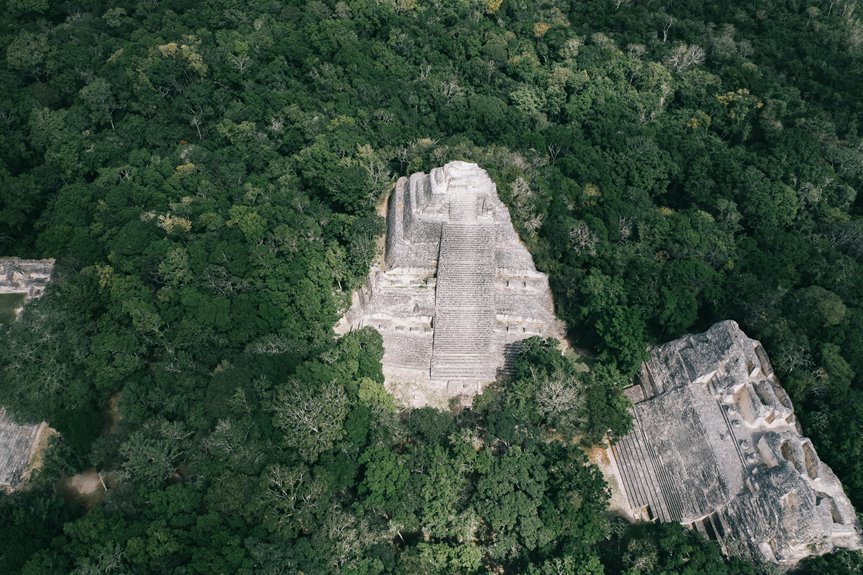The Akamas Peninsula is UNESCO-worthy due to its exceptional biodiversity, hosting over 200 endemic bird species and rare flora like the Akamas tulip, alongside unique geological formations such as the Troodos Ophiolite Complex, which offers insights into Earth’s crustal formation. Its cultural heritage, including ancient settlements and historical sites, further enhances its value. However, threats like deforestation and development highlight the urgent need for protection. UNESCO designation could promote sustainable tourism, balancing conservation with economic growth, ensuring this natural and cultural treasure endures for future generations. Explore further to discover how its unique features make it a global heritage site.
Key Takeaways
- Akamas Peninsula is home to over 200 endemic bird species and rare flora, as well as habitats for critically threatened species like loggerhead turtles and Mediterranean seals.
- The area features unique geological formations, including the Troodos Ophiolite Complex, offering insights into Earth’s crustal formation and geological history.
- It holds significant cultural heritage, including ancient Mycenaean settlements, Neolithic sites, and Byzantine basilicas, reflecting its historical and religious importance.
- The peninsula’s diverse ecosystems, such as coastal terraces and forests, along with its geological landmarks, fulfill UNESCO’s natural and mixed heritage criteria.
- Its potential for sustainable tourism aligns with UNESCO goals, promoting conservation and eco-conscious travel while preserving its natural and cultural richness.
Biodiversity and Unique Ecosystems
Why is the Akamas Peninsula a contender for UNESCO recognition? Its staggering biodiversity makes it a natural fit for UNESCO biosphere reserve designation. You’ll discover over 200 endemic bird species, making it a critical migration corridor for thousands of birds annually. Rare flora, such as the Akamas tulip and Akamas centaurea, are found nowhere else on Earth, highlighting its botanical significance. The peninsula also shelters globally threatened species like the loggerhead turtle, peregrine falcon, and Mediterranean seal. With over 600 plant species, including 17 bee orchids and two endemic cyclamen, Akamas boasts exceptional floral diversity. Its ecosystems-forests of pine and juniper, dramatic gorges, and pristine coastlines-create a mosaic of habitats supporting endangered and endemic life. This natural heritage underscores why the Akamas Peninsula is central to the UNESCO biosphere reserve proposal, emphasizing conservation and sustainable management of its unique ecosystems.
Geological Significance and Landforms
The Akamas Peninsula’s geological significance is as remarkable as its biodiversity, with landforms that tell a story of Earth’s history. The Troodos Ophiolite Complex, a rare exposure of oceanic crust uplifted onto land, offers unparalleled insights into the Earth’s crustal formation. The Mamonia Complex adds to this diversity, creating unique geological formations that highlight the region’s tectonic evolution. Along the coastline, calcitic sandstones, or Aiolianites, formed during the glacial period, provide a window into past climatic conditions. Avakas Gorge, carved through sedimentary rocks, stands as a striking example of erosional processes. Raised marine terraces along the coast further illustrate the peninsula’s tectonic uplift and historical sea-level fluctuations. These features not only enrich the region’s geological heritage but also serve as essential educational tools for understanding Earth’s dynamic processes. Together, they make Akamas a site of profound geological importance, worthy of conservation and recognition.
Cultural and Historical Heritage
Named after the Homeric hero Akamas, the peninsula carries a rich tapestry of cultural and historical significance, deeply intertwined with its geological heritage. You can explore ancient Mycenaean-era fortified settlements like Maa-Palaiokastro, which reveal the presence of early advanced civilizations. The defensive walls at Lara, built in Mycenaean style, highlight strategic engineering from antiquity. Neolithic and Chalcolithic sites, such as Aspros, showcase early human habitation and agricultural practices, while Hellenistic, Roman, and Byzantine settlements illustrate the peninsula’s enduring role as a cultural crossroads. Sixth-century basilicas further underscore its historical and religious importance. Together, these sites create a living archive of human history, from prehistory to the rise of Christianity, making the Akamas Peninsula a testimony to the Mediterranean’s shared heritage. Its layered history, intertwined with its natural landscapes, reinforces its cultural and historical value as a UNESCO-worthy site.
Conservation Status and International Recognition
Just as Akamas Peninsula captivates with its historical legacy, it also stands out as a region teeming with biodiversity, hosting over 200 bird species and unique wildlife such as loggerhead turtles and peregrine falcons. As part of the Natura 2000 network since 2018, it protects 7,762 hectares of essential ecosystems, though this area is smaller than initially recommended. Its significance was further underscored by its nomination as a UNESCO Biosphere Reserve from 1987 to 1995, evidence of its global conservation value. The peninsula is home to rare, endemic plants like the Akamas tulip and centaurea, among the world’s rarest species. These unique ecosystems make it a critical site for international conservation efforts. By preserving its biodiversity, the Akamas Peninsula not only safeguards its natural heritage but also contributes to global sustainability goals, offering a living laboratory for balanced human activity and environmental stewardship.
Threats to Its Ecological Integrity
While the Akamas Peninsula stands as a critical haven for biodiversity, habitat destruction and human activities threaten its fragile ecosystems. Deforestation and habitat fragmentation are alarmingly shrinking its forests, which now cover only 18.7% of Cyprus, down from 93%. Government development plans, including 85 km of roads and 14 amenity hubs, encroach on natural habitats, risking the survival of endangered species. Despite being part of Natura 2000 since 2018, insufficient protected zones leave many species exposed to daily threats. Tourism, though critical, exacerbates these issues, as quad biking and boat trips cause erosion and disturb wildlife. The lack of transparency in governmental development plans raises concerns about whether adequate measures are in place to safeguard the peninsula’s ecological integrity. These pressures underscore the urgent need for balanced conservation efforts to preserve Akamas’ unique biodiversity and natural heritage.
Why Akamas Deserves UNESCO Protection
With its stunning geological formations, rich biodiversity, and deep cultural heritage, the Akamas Peninsula stands as a compelling candidate for UNESCO World Heritage recognition. The Troodos Ophiolite Complex and Avakas Gorge showcase its unique geological significance, while the presence of endemic species like the Akamas tulip and centaurea highlights its exceptional biodiversity. As part of the Natura 2000 network, Akamas is already recognized for its ecological importance, providing a habitat for over 200 bird species and serving as an essential stopover for migratory birds. Its cultural heritage, including archaeological sites from the Neolithic period, adds another layer of value, making it an ideal mixed UNESCO World Heritage Site. Protecting Akamas through UNESCO designation would safeguard its natural and cultural treasures for future generations, ensuring sustainable conservation of this irreplaceable landscape.
Potential of UNESCO Designation for Sustainable Tourism
The potential of UNESCO designation to open up sustainable tourism opportunities in the Akamas Peninsula is significant. As a region rich in biodiversity, with over 200 bird species and rare plants like the Akamas tulip, the area meets UNESCO’s natural heritage criteria. Its cultural and historical sites further enhance its appeal, offering a unique blend of ecological and archaeological attractions. Sustainable tourism activities, such as hiking and birdwatching, align perfectly with UNESCO’s mission to promote responsible travel and conservation. While Akamas has been a Natura 2000 site since 2018, UNESCO designation could elevate its status, attracting global attention and fostering eco-conscious travel. This recognition would also strengthen efforts to protect the peninsula from developmental threats, ensuring its pristine landscapes and historical treasures are preserved for future generations. By leveraging UNESCO’s framework, Akamas can become a model for sustainable tourism, blending heritage preservation with economic growth.
Frequently Asked Questions
What Is the Geology of the Akama Peninsula?
The Akamas Peninsula’s geology centers on the Troodos Ophiolite Complex, forming its rugged mountains. Scattered Mamonia Complex rocks add geological variety. Aiolianites, shaped during the glacial period, line the coast, while erosion has carved out gorges like Avakas. Raised marine terraces reveal uplifted ancient shorelines, illustrating the peninsula’s rich geological history and natural heritage.
What Animals Are in the Akamas National Park?
You’ll discover an incredible variety of wildlife in Akamas National Park. Over 200 bird species, such as Bonelli’s eagles and long-legged buzzards, call this park home. Loggerhead turtles find safe nesting sites here, while peregrine falcons thrive in the area. The Egyptian fruit bat, Cyprus’ largest and Europe’s only species, adds to the park’s biodiversity. Mediterranean seals occasionally appear along the coastline, making Akamas a haven for diverse wildlife.
Where Is the Akamas Peninsula?
The journey of a thousand miles begins with one step. You’ll find the Akamas Peninsula at the westernmost tip of Cyprus, nestled in the Paphos district. Access it by car via a rugged road or by boat from Latchi port, near the Baths of Aphrodite. This Natura 2000 site spans 17,000 hectares, with diverse landscapes like Avakas Gorge. A haven for biodiversity, it’s a natural and cultural gem worth preserving.
What Are the Trails in Akamas Peninsula National Park?
You’ll explore the Aphrodite Trail, blending natural beauty with historical sites. The Adonis Nature Trail offers diverse landscapes, while the Smigies Trail challenges you with its rugged terrain. The Bath of Aphrodite Trail captures geological and cultural significance. Finally, the Bonelli’s Eagle Trail focuses on birdwatching. These trails highlight Akamas Peninsula’s rich biodiversity and UNESCO-worthy heritage.
Conclusion
As you stand on the edge of Akamas Peninsula, the whispers of its ancient past mingle with the roar of the Mediterranean. This fragile haven, teeming with biodiversity and steeped in history, hangs in the balance. Will UNESCO recognition bring salvation, or will it open the door to overexploitation? The clock ticks, urging us to act before this ecological and cultural jewel fades into memory. The future of Akamas lies in our hands.

Meet Natalie, who has lived on Cyprus for the last 10 years. She loves exploring the beautiful nature of the island, like quiet forests and untouched beaches. Natalie has lots of cool experiences to share. Join her as she talks about her adventures in Cyprus.

